How do novelists write about faith in a culture that's moving past it?
Oddly, the less people know about something the harder it is to tell them about it.

The easy part of representing Christianity would seem to be the part to do with representing it as a human, social activity. Whatever else they are, churches are groups, tribes, institutions, with particular rules and habits of relating, and micropolitics. They have hierarchies both of the formal kind and of charisma and informal authority; and they have demanding ideals of behavior that most probably will stand in temptingly ironic contrast to the actual behavior of the people involved.
All of which is rich fictional material in exactly the same way that the life of any defined group provides rich material for stories. We like hearing about villages, we humans; and maybe most of all we enjoy villages stirred up by some principle, to give a narrative tug to events, as ironic as you like. This is the recipe for Anthony Trollope’s explorations of the cathedral close at Barchester, and for Barbara Pym’s novels of spinsters at evensong. It would seem that you could enter into this fictional territory without any metaphysical commitments, equipped only with a descriptive curiosity and a broad imaginative sympathy. Representing faith this way would be only as difficult—that is, fiendishly difficult, but let’s not be downhearted—as representing any other idea-influenced piece of human activity. It wouldn’t pose a particular problem.
Read our latest issue or browse back issues.
But although people go on writing this kind of story of religious life all over the planet, there hasn’t been a lot of Trollope or of Pym produced locally, lately; not in Western Europe, not in England. And I think our position in a culture where the religious tide has gone a very long way out, by global standards—leaving us on these secular mudflats, surrounded by curious shells and rusty bicycles—shows us something that may not be apparent in other places, which is that the apparently descriptive, merely curious village-life novel of faith did in fact quietly depend on a metaphysical commitment. It was (is) built on a shared assumption between writer and reader that a disposition of life around religion makes sense. Makes, in fact, such basic sense that the sense it makes can be left offstage and the author can concentrate on all the secondary human consequences of that sense, ramifying all over the place in lovely narrative patterns. But when that underlying assumption is removed, the village life of Christians stops being just another intelligibly villagey panorama and becomes mysterious. It dwindles into anthropology, to be explained as it goes; it becomes exotic, science-fictional, a zoo for the bizarre; it becomes a mode of story, often, whose point is to criticize, to indicate a confinement from which the characters could—should—break free.
To say this is not to buy into the legend that some kind of definitive secular disenchantment is available, after which everything will only mean what it really means, and our lives, and presumably our fictions, will stand on the plain, real ground. The Christian mythology may go away, but the mythic dimension of experience will not; any plausible human life will remythicize far faster than Richard Dawkins can keep up with, brandishing the hedge trimmer of “reason.” The New Atheists are trying to carve the Green Man into static topiary, and it won’t work. But particular bonds of sympathy can certainly be severed. The simplest way of putting this is that there won’t be much of a market for a book called Scenes from Clerical Life if no one has a clue what the life of the clergy is like.
Oddly, then, the further that Christianity recedes from most people’s everyday experience, the less available becomes the apparently most straightforward way of representing it. And the more important become the other ways in which the life of faith can take on fictive life.
There is, for example, the novel that renders, in concrete and particular imagined lives, Christianity’s central theological drama of redemption: the story of depravity and grace. I’m thinking of the mid 20th-century Catholic novelists here, in whose work that story can often be explicit, appearing under its own name, with clear theological labels attached. Graham Greene, Muriel Spark, Flannery O’Connor: all demonstrating the specific gravity of loss, cruelty and destruction within experience, and a redemptive turn toward hope, as being intelligible—intelligibly desired, intelligibly yearned for—within that same experience. The theme was explicitly otherworldly, with the whole story resting upon a possibility for hope not to be accounted for from the usual calculus of events, but it was arrived at in a very worldly and often darkly comic way, with the story’s dive into depravity giving it the authority of pessimism, of really well-informed squalor and sleaze and darkness visible.
But there is also a version of the novel of redemption that comes without this kind of explicit labeling or theological framing—with the theological motif being, as it were, digested into experience to the point of invisibility. If I was being mischievous, I’d call this the Protestant version, with the apparatus of redemption absorbed with no remainder into the sufficient material of the individual life. But I’m not sure that’s a fair categorization of, for instance, the diffused Anglo-Catholic awareness of the possibility of grace that threads through the work of Penelope Fitzgerald, or of, say, Alasdair Gray’s 1982, Janine, which records in frequently pornographic detail the long dark night of the soul of a Scottish businessman, as well as the joy that cometh in the morning. He certainly thought of that book as being locked in combat with his childhood Calvinism, and there’s a clue there to the continuing viability of the implicit rather than explicit version of this kind of theologically Christian novel. It can be written without a conscious intention by the writer.
Because the narrative of redemption—of the stone rolled away, and the weight of sorrow overturned—still forms one of the deep structures of the culture hereabouts, it comes easily and, as it were, naturally to the hand of someone who may think that they are merely at work, without presuppositions, in the fields of meaning. I wouldn’t want to overstate the unconscious intention in Alasdair Gray’s case, because 1982, Janine does feature an intervention in the margins by the voice of God and it does say at the end that it was completed “on retreat, at the monastery of Santa Semplicitá”—but this does seem to me to be a mode in which the novel in Western Europe is likely to go on writing Christian faith unwittingly, and for quite some time.
However, as awareness of the Christian nature of the culture’s materials dwindles, the third kind of fiction in my rapidly assembled and ad hoc taxonomy seems likely to become most important of all. The kind, that is, that can speak communicatively of faith to readers beyond the bounds of experienced familiarity with it, and beyond the bounds of conscious assent to it, because, rather than exploring the (social) relations of Christians with each other, or showing forth the theological patterning of experience, it takes as at least part of its subject the relationship of Christians with God. The kind that tries to realize, on the page, with the verbal tools of the novelist, the orientation to the world that results when somebody holds that, feels that, behaves as if the particular rooms they are in always have another unnumerated door or window, opening onto a different and overwhelming domain. The kind where the particular light of one morning is held to be a manifestation of a general light. The kind where part of the point of what is being carefully reported about everyday experience is that it faces onto something else. That something else, of course, not being a verbal fabric at all. Being made of the Word, that is, not of our vocabulary.
As the Reverend John Ames says in Marilynne Robinson’s Gilead, “you must not judge of what I know by what I find words for”—except of course that the readers of novels do judge, exactly, by what the writer has found words for. The task of finding expressible language for the inexpressible is inherently impossible. The effort begins in the admission of inevitable defeat.
For me, Robinson’s Gilead and, in their different way, its successors Home and Lila are the best, most grace-touched defeats there have been in fiction for a very long time. And the foundation of their power is their scrupulous fidelity to the integrity of viewpoint. They inhabit the viewpoints of John Ames and then Glory Boughton and Lila Ames with more, not less, attention to the particularity and limits of those imagined human selves, because they are trying as well to make an impossible realization of grace on the page. There is not a word of omniscience, in the narrative sense, in any of them. They do not for an instant exploit the capacity of fiction to condense the hopes of Christianity into direct narrative, on the authority of the author, and to project them onto the screen of the story as if they were present in the same solid way as furniture and trees are present. Which they would be, but only within the terms of the story, only till you put the book down. God would be a special effect. There would be no claim of witness, of observation palpably grounded; only the claim of eloquence. Instead the Christian eloquence of Gilead and Home is directed toward the resistant reality of experience, and toward what we may find in it, and maybe beyond it.
This essay is excerpted from Francis Spufford's book True Stories and Other Essays, published this month by Yale University Press, © 2017 Francis Spufford. Excerpted by permission.
A version of this article appears in the October 11 print edition under the title “Three ways of writing faith.”






